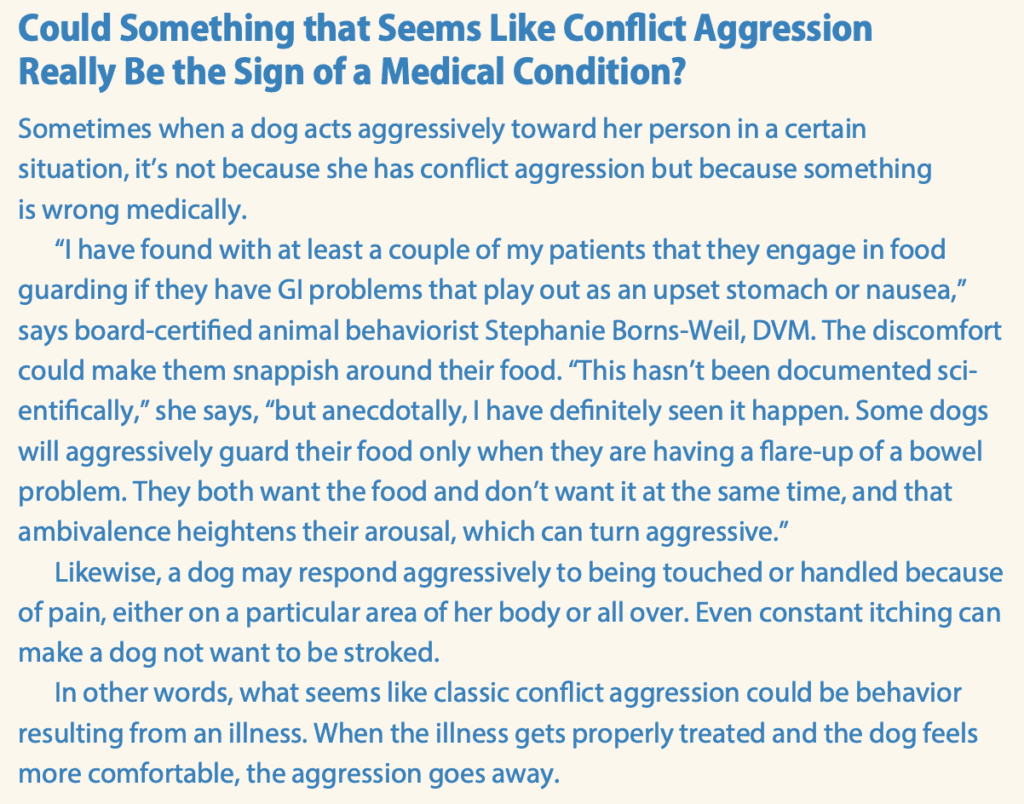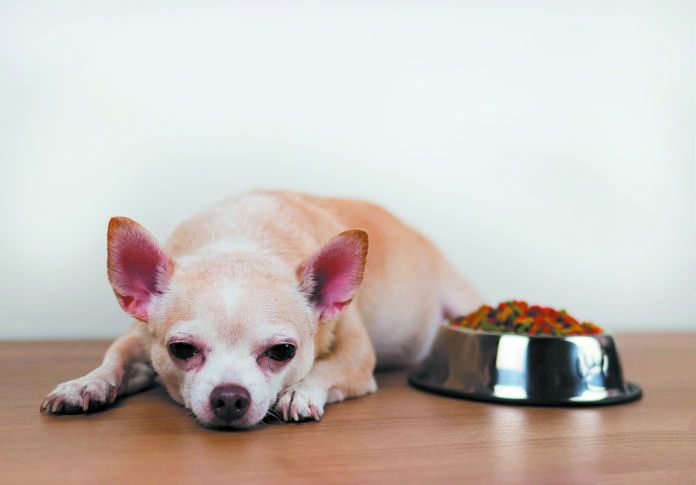If a dog gives a warning bark or snaps when the person who takes care of her goes near her food bowl or picks up one of her toys, she she may be afflicted with what is known as conflict aggression. A dog with conflict aggression might also sound a warning growl when the person goes to touch her, perhaps even just to attach the lead in order to go out for a walk.
The conflict is an inner one. The dog does not understand what is happening in her life, and that makes her uncomfortable. Because she finds her situation confusing or challenging, she does not know how to respond to the person she loves and relies on. As a result, she may overreact to retain possession of her toys or food, or to prevent an unwanted interaction like being given her medicine.
Conflict aggression used to be seen as a battle for control and dominance. Treatment was about reestablishing a dog’s human caregiver as the “leader” by employing a “no free lunch” or “nothing in life is free” program. The essence of the program was to make everything the dog needed conditional. She had to sit before getting meals, walks, trips outside to eliminate, and so on. By making it clear that the dog had to defer to her person for everything, the program was, in essence, a way of teaching the dog who was in control.
“But there are problems with this approach,” says Stephanie Borns-Weil, DVM, head of the Tufts Animal Behavior Clinic. “Helping a dog past conflict aggression is not about control but about communication, understanding, and trust. Absolute control does not leave room for the kind of enriching relationship that we can have with dogs.”

To most effectively treat conflict aggression, Dr. Borns-Weil explains, caregivers must not only improve communication but also avoid situations that engender misunderstanding — and conflict — until a dog learns the skills needed to manage them.
Here’s how to set up a dog for success.
1. Manage the environment. First, keep the dog from situations that trigger an aggressive reaction. For instance, Dr. Borns-Weil points out, some dogs can’t handle high-value treats, like a peanut butter-stuffed Kong. They guard a resource like that with enough ferocity that it’s dangerous just to walk near them when they’re gnawing on it. It may even be that their anxiety about having the treat in the presence of people outweighs the enjoyment they get from it. In such a case, it serves the dog better not to be offered the item, at least not when people are present. That’s not a punishment. It’s a way of maintaining a dog’s composure while insuring your own safety.
Limiting a dog’s choices to what she can reasonably handle is akin to not letting a pre-schooler play with scissors until she has learned to use them safely even if she very much wants be cutting paper; there’s just too much opportunity for a mishap. Such precautions also keep a dog from becoming even more sensitized to what she perceives as something she has to guard, which only reinforces the aggressive response by triggering it over and over.
Managing the environment can look different depending on what gets a dog going. For some dogs it could mean not letting them on the couch because then they don’t let people on when they are there. They are too invested in guarding their perimeter or may startle too easily when resting. For other dogs it means feeding them in a room behind a baby gate so they don’t become anxious that someone is going to walk by and take their food. For yet others, it could translate to always leaving on their collar so that they don’t require that bit of handling when it’s time to go out.
Managing the environment also means that caregivers must be very clear and consistent in their expectations. Dogs with conflict aggression do best when they know what to expect as well as what is expected of them. For example, if a dog is not allowed to jump up on people, he should not be petted sometimes and scolded at other times when he puts his paws on their shoulders.
2. Improving communication and cooperation through training. Through positive reinforcement training, a dog can learn behaviors that you will applaud and that will in turn make her feel good about herself and her relationship with you. Such behaviors can be anything from learning to give you a high five in exchange for a treat to going through a hoop.
Getting a dog used to training in positive ways that don’t set her off can also help her when she needs to be trained to get through specific situations that might otherwise make her turn aggressive. Let’s say your dog has developed an eye disease for which she needs eye drops three times a day, but she goes to bite you when you try to apply the medicine. Instead of holding her down with thick gloves, you can teach her to cooperate by coming to one particular spot in exchange for a very delicious treat. It has to be really delicious, like a hunk of liver or beef. When she lets you apply the drops, you give her the treat. She appreciates not only the reward but also the predictability of the scenario. Again, a dog with conflict aggression very much needs to know that things work in a consistent fashion, that she can reliably depend on circumstances to go a certain way. That ratchets down her anxiety.
“It’s all about opening up lines of communication,” Dr. Borns-Weil says, “finding a common language that signals kindness and compassion rather than forcing a dog into submission by threatening her that she won’t eat or won’t be taken for a walk unless she obeys your cue to sit or do something else. Lunch should be free, perhaps even more so for a dog who’s so anxious she feels she needs to guard it. Remember,” the doctor adds, “when you’re dealing with a dog who has conflict aggression, you’re dealing with someone who’s struggling, who is hyper-aroused because of underlying anxiety. She needs to know you will take care of her and love her no matter what. What she does not need is for you to make her feel even more at risk.”





